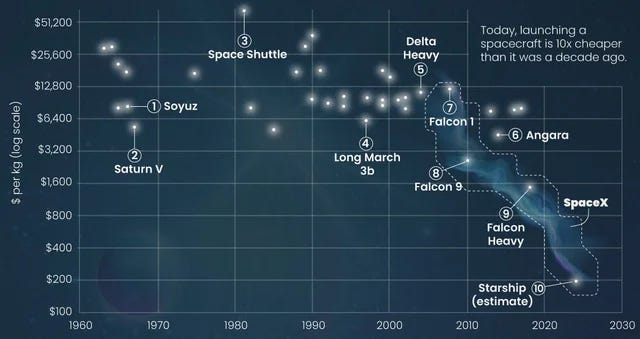Time For Elon To Go Nuclear
Can he drop the cost of electricity by 90% in ten years, like he did with rockets?
The Visual Capitalist reports that Elon Musk has achieved a 10x decrease in the cost of lifting a kilogram (2.2 pounds) of cargo into orbit. His operating principle is pretty simple: launch, learn, repeat.
This decrease in cost has a great additional benefit. He’s been able to put thousands of satellites into orbit. The more you make, the more you learn, the more you learn the lower your costs, the lower your cost the lower your price. The lower the price the more you sell. Is Elon is the fastest learner on the planet?
Musk launched Starlink with the first 60 satellites on his Falcon 9 rocket in May of 2019. Since then 7,022 satellites have been put into orbit with 6,346 operational. Starlink satellites make up over 60 percent of all active spacecraft in orbit. Today the Starlink satellites beam internet access to over 3 million customers in all 50 states.
Nice chart here from Bret Swanson.
Elon has also been a leading proponent of solar power and his battery storage systems are some of the best in the world. But sunshine will only get us only so far. Colonizing Mars will require reliable, abundant, and affordable power generation. Humanity requires this kind of power generation right here on Earth. Unlike sunshine, not everyone has access to abundant electrical power. People living in American use 16.4 times more energy per capita than do those living in Africa.
We also need billions and billions of kilowatt hours to power the AI future. The only zero-carbon energy source that can do this is nuclear. The U.S. was on a nuclear power learning curve until the day after the Three Mile Island accident on March 28, 1979. We’ve been going backwards since. The first new U.S. nuclear reactor since 2016 is now in operation. The Energy Information Institute notes that “with 95,881 MW of nuclear power capacity at 93 operating commercial reactors, the United States has more nuclear capacity than any other country. Nuclear power plants produce nearly 20% of the country’s electricity.”
The world’s first nuclear-powered submarine, the USS Nautilus, was launched in 1954. We now have 72 nuclear-powered submarines that have been operating for 60 years without incident. A modern nuclear-powered submarine will serve its entire 30- to 40-year life without ever needing refueling. We also have 11 nuclear-powered aircraft carriers.
The Nuclear Regulatory Commission (NRC) was created in 1974 and reports that the two reactor designs most recently certified resulted in compliance costs of between $45 million and $70 million. The review process typically takes seven years and requires millions of pages of forms. These costs include hourly fees for pre-application interactions between NRC and the applicant, the NRC’s review of the application itself, and the NRC’s review of application revisions that were submitted by the applicant. The NRC is required by law to recover approximately 90% of its annual budget from the companies and people they regulate. Their incentive is to maximize compliance costs, not to maximize the value to the taxpayers and buyers of electricity.
But change is happening and fast. Microsoft recently signed a 20-year power purchase agreement to reactivate one of the Three Mile Island reactors. Google and Amazon have made significant investments in small modular reactors (SMRs). Read more about these innovations here and here.
Donald Trump and Elon have floated the idea of a Department of Government Efficiency (DOGE). Implementation of such a department is unlikely given the composition of a Congress continually running for re-election and the hordes of lobbyists lubricating the cash flows. A much better department would be the Department of Power Abundance whose objective would be to reduce the price per kilowatt hour to 2 cents. The average price per kWh in the U.S. today is 17.8 cents. Reducing the price per kilowatt hour to only 2 cents seems like an impossible objective, but most people thought the cost of sending cargo into outer space would only get higher. When Elon focused on this problem, however, the cost fell by 90 percent. His vision is to reduce it another 90 percent. He’s going from $100 to $1.
In 1885, John D. Rockefeller wrote one of his partners, “Let the good work go on. We must ever remember we are refining oil for the poor man and he must have it cheap and good.” He pushed the price down from 58 cents to 8 cents a gallon (86 percent).
Elon is entrepreneurship. He’s involved in a variety of companies including SpaceX, Tesla, X (formerly Twitter), Starlink, xAI, The Boring Company, and Neuralink. The only entrepreneur that comes close to Elon in creative innovation is Thomas Edison with his 1,093 patents. Edison worked to electrify the world but he understood that without abundant and affordable electricity all of his inventions would be nothing more than novelty gadgets for the rich. Edison’s one-time employee Nikola Tesla focused on understanding energy and making it abundant. It’s time for Elon to pursue the true vision of his company namesake.
You can enjoy our new course on the Economics of Human Flourishing at the Peterson Academy.
We explain and give hundreds of examples why more people with freedom means much more resource abundance for everyone in our book, Superabundance, available at Amazon.
Gale Pooley is a Senior Fellow at the Discovery Institute and a board member at Human Progress.









Decades-ago experience in the USA and much more recent experience in South Korea shows that nuclear can definitely be built at 25% or even 10% of current costs. The NRA must be abolished or drastically reformed. The linear no-threshold regulatory principle is absurd and must be thrown out.
Agreed. I'm a big supoorter of nuclear energy. Fission now, add in fusion asap.